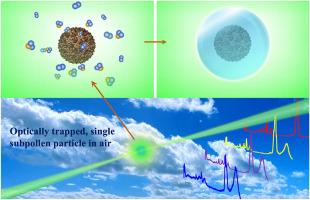光学捕获的单个亚花粉颗粒与大气水相互作用的表面活性
IF 2.9
3区 环境科学与生态学
Q2 ENGINEERING, CHEMICAL
引用次数: 0
摘要
亚花粉颗粒(SPPs)是花粉破裂过程中释放的花粉碎片,对大气生物气溶胶负荷有贡献,是初级生物气溶胶颗粒的重要来源。这些颗粒很小,可在大气中长时间悬浮,并可作为云凝结核(CCN),影响人类健康和气候。然而,SPPs与大气水相互作用所产生的地表活动,使它们能够发挥CCN的作用,尚不清楚。在这项工作中,我们应用光捕获拉曼光谱(OT-RS)在单粒子尺度上研究了SPPs与大气水的相互作用。通过分析SPPs的单粒子拉曼光谱,我们确定了不同的成分,如蛋白质、脂肪酸和脂质,对应于花粉粒内部或外部的不同部分。我们证明了具有较高吸湿性物质(如氨基酸和蛋白质)浓度的spp可以在高相对湿度条件下作为CCN。本文还讨论了大气水与SPPs相互作用引起的表面改性。此外,我们操纵含有NaCl的水滴覆盖SPPs表面,模拟海洋喷雾气溶胶与SPPs之间的相互作用。结果显示,当SPPs暴露于盐水溶液和纯水时,其表面发生了明显的变化。这项工作阐明了在模拟大气条件下SPPs的吸水和云形成的动态过程,并提供了一种单粒子方法来明确表征SPPs和大气水之间的表面活性。本文章由计算机程序翻译,如有差异,请以英文原文为准。

Surface activity of optically-trapped single subpollen particle interacting with atmospheric water
Subpollen particles (SPPs), fragments of pollen released during pollen rupture, contribute to the atmospheric bioaerosol load and are an important source of primary biological aerosol particles. These particles are small, can be suspended in the atmosphere for long periods, and can act as cloud condensation nuclei (CCN), influencing human health and climate. However, surface activities resulting from the interaction of SPPs with atmospheric water, which enable them to act as CCN, are still unclear. In this work, we applied optical-trapping Raman spectroscopy (OT-RS) to study the SPPs’ interaction with atmospheric water on a single-particle scale. By analyzing single-particle Raman spectra of SPPs, we identified different compositions, such as proteins, fatty acids, and lipids, corresponding to different fractions inside or outside of a pollen grain. We demonstrated that SPPs with higher concentrations of hygroscopic materials, such as amino acids and proteins, could act as CCN under high relative-humidity conditions. The surface modification caused by the interaction between atmospheric water and SPPs is also illustrated in this study. Additionally, we manipulated water droplets containing NaCl to coat the surface of SPPs, simulating interactions between sea-spray aerosol and SPPs. The results revealed distinct surface modifications when SPPs were exposed to saline solutions and pure water. This work illustrates the dynamic process for water uptake and cloud formation of SPPs under simulated atmospheric conditions and provides a single-particle method to explicitly characterize the surface activity between SPPs and atmospheric water.
求助全文
通过发布文献求助,成功后即可免费获取论文全文。
去求助
来源期刊

Journal of Aerosol Science
环境科学-工程:化工
CiteScore
8.80
自引率
8.90%
发文量
127
审稿时长
35 days
期刊介绍:
Founded in 1970, the Journal of Aerosol Science considers itself the prime vehicle for the publication of original work as well as reviews related to fundamental and applied aerosol research, as well as aerosol instrumentation. Its content is directed at scientists working in engineering disciplines, as well as physics, chemistry, and environmental sciences.
The editors welcome submissions of papers describing recent experimental, numerical, and theoretical research related to the following topics:
1. Fundamental Aerosol Science.
2. Applied Aerosol Science.
3. Instrumentation & Measurement Methods.
 求助内容:
求助内容: 应助结果提醒方式:
应助结果提醒方式:


